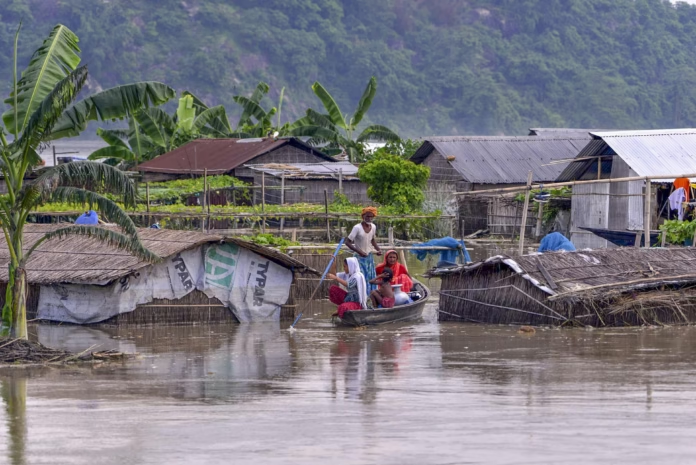Assam, a northeastern state of India, is grappling with severe flooding in 2025, a recurring challenge exacerbated by climatic changes and infrastructural inadequacies. The floods have disrupted daily life, displaced communities, and tested the resilience of both urban and rural infrastructures.
Extent of the Flooding
The current flood situation has affected numerous districts across Assam. Heavy rainfall has led to the overflowing of rivers, inundating vast areas, damaging crops, and displacing residents. The Assam State Disaster Management Authority (ASDMA) has been actively monitoring the situation, providing updates, and coordinating relief efforts.
Urban Challenges in Guwahati
Guwahati, the state’s largest city, has faced significant challenges due to the floods. Areas such as Nabin Nagar, Anil Nagar, Zoo Road, and RG Baruah Road have experienced severe waterlogging, disrupting transportation and daily activities. The city’s rapid urbanization, coupled with inadequate drainage systems, has exacerbated the flooding problem.
Despite initiatives like the “Mission Flood-Free Guwahati,” the city continues to struggle with effective flood management. Encroachments on wetlands and unplanned urban development have reduced the city’s natural water absorption capacity, leading to frequent inundations even with moderate rainfall.

Government Initiatives and Responses
In response to the crisis, the Assam government has implemented several measures:
- Flood Drills and Preparedness: From April 15 to 30, flood drills were conducted across the state to enhance readiness. These drills are set to continue in production mode from May 1 to October 31, aiming to improve response times and coordination during actual flood events.
- Deployment of NDRF Teams: The National Disaster Response Force (NDRF) has been strategically positioned in high-risk districts, including Cachar, Barpeta, Jorhat, and Dibrugarh, to facilitate rapid deployment during emergencies.
- Infrastructure Projects: The government has unveiled a roadmap to combat artificial floods in Guwahati, focusing on desiltation work and improving drainage systems. The first phase of this project targets completion by March, aiming to mitigate flooding in the upcoming monsoon season.
Long-Term Solutions and Future Preparedness
Addressing Assam’s flooding issue requires a multifaceted approach:
- Restoration of Natural Water Bodies: Protecting and restoring wetlands can enhance the natural absorption of excess rainwater, reducing the impact of floods.
- Urban Planning and Regulation: Implementing strict regulations against encroachments and ensuring that urban development projects include adequate drainage and flood management systems is crucial.
- Community Engagement: Educating communities about flood preparedness and involving them in planning can lead to more effective and sustainable solutions.
- Technological Integration: Utilizing Geographic Information Systems (GIS) and other technologies can aid in mapping flood-prone areas, predicting flood events, and planning evacuation routes.

Impact on Agriculture and Livelihoods
The agricultural sector in Assam has been one of the hardest hit by the floods. Thousands of hectares of paddy fields and vegetable farms have been submerged, wiping out crops that are crucial to the local economy and food supply. Many small-scale farmers, who rely solely on seasonal harvests, are now facing immense financial distress. With livestock lost and irrigation disrupted, the long-term consequences on food production in the region could be devastating unless urgent support is provided.
Health Risks and Sanitation Issues
Floods in Assam are often accompanied by secondary crises, particularly related to public health. Contaminated water sources, stagnant water bodies, and disrupted sanitation systems lead to outbreaks of waterborne diseases such as cholera, diarrhea, and dengue. In overcrowded relief camps, the spread of infections becomes a serious concern. Authorities have begun deploying medical teams to affected districts, but access to healthcare remains uneven, especially in remote rural areas.
Displacement and Relief Measures
As of now, thousands of residents have been displaced from their homes and are taking shelter in makeshift relief camps set up by the state government and local NGOs. While these camps provide basic food, water, and shelter, they are often overcrowded and lack privacy and adequate hygiene. Children, the elderly, and pregnant women are particularly vulnerable. Relief distribution efforts are ongoing, but logistical challenges and road damage have hampered operations in some flood-ravaged regions.
Role of Civil Society and Volunteers
Amid the crisis, civil society groups, student unions, and volunteers have stepped up to assist in flood relief efforts. Community kitchens, rescue boat operations, and donation drives have been launched across the state to support affected families. In many areas, local volunteers have reached flood victims faster than formal relief teams, highlighting the crucial role grassroots organizations play during disasters. Their efforts, however, need better coordination and support from official agencies to scale effectively.

Climate Change and Future Outlook
Experts have repeatedly pointed to climate change as a major driver of the increasing frequency and intensity of floods in Assam. Erratic rainfall patterns, deforestation, and rising river levels due to melting Himalayan glaciers all contribute to the worsening scenario. Going forward, both the state and central governments must prioritize climate-resilient infrastructure, better flood forecasting systems, and stricter environmental regulations. Without proactive measures, Assam may continue to suffer year after year, with greater costs to life and economy.
The 2025 floods in Assam underscore the urgent need for comprehensive flood management strategies that combine infrastructural development, environmental conservation, and community engagement. While immediate relief efforts are essential, long-term planning and sustainable practices are imperative to mitigate the impact of future floods and safeguard the lives and livelihoods of Assam’s residents.
Also Read: Bihu: The Heartbeat of Assam’s Culture and Tradition












